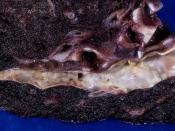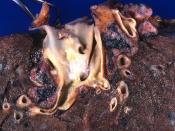Atherosclerosis is a disease of the heart caused by fat deposits in the walls of blood vessels, mainly the arteries. Atherosclerosis can occur in any artery, but it usually occurs in larger arteries around the area where they branch. The place where atherosclerosis is found most commonly is in the coronary arteries. This disease can occur in anyone, but most commonly is found in males, smokers, people with high cholesterol levels, and people who do not exercise frequently.
Atherosclerosis can be found in some people in their late teens. It begins as small streaks of fat deposits just underneath the smooth lining of the arteries. Over time, the streaks of fat deposits become accumulations of fat, or plaque. Once plaques have become large enough to project into the artery, they break or crack. When this happens, the blood begins to clot over the plaque, obstructing the artery. A piece of the plaque may break off while in a large artery, and be carried through the bloodstream to a smaller vessel.
When this blockage occurs, it is called an embolism. This process, caused by fat deposits, or plaque, often completely block a coronary artery, causing a heart attack.
There is no known reason as to why some people develop atherosclerosis and some people do not. There are, however, several risk factors associated with developing the disease. Some risk factors can be altered to be less at risk for developing atherosclerosis, while some factors cannot be changed. Age, heredity, and gender are risk factors that cannot be changed to lessen the risk of developing the disease. Risk factors that can be altered are smoking, cholesterol levels, obesity, and exercise.
High cholesterol levels in the blood increase the risk of developing atherosclerosis. Cholesterol is a normal fat found in the body, and makes...


